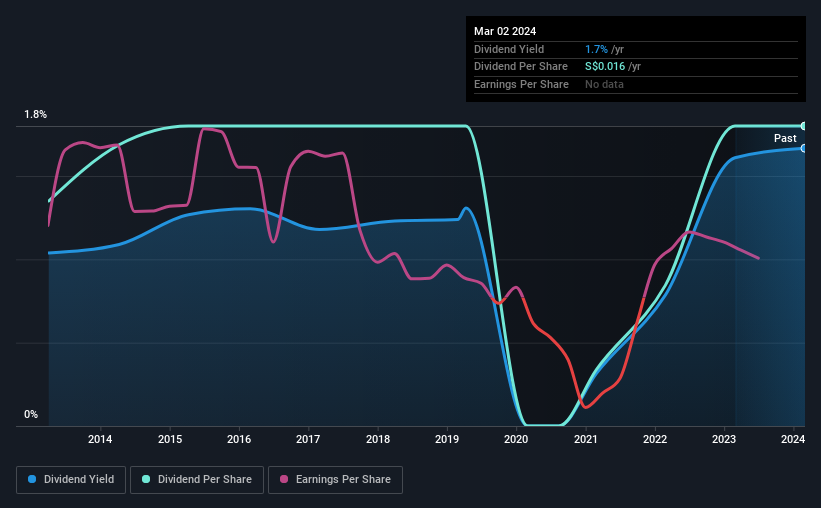Bonvests Holdings (SGX:B28) Is Paying Out Less In Dividends Than Last Year
The board of Bonvests Holdings Limited (SGX:B28) has announced it will be reducing its dividend by 50% from last year's payment of SGD0.016 on the 26th of May, with shareholders receiving SGD0.008. This means that the annual payment is 1.7% of the current stock price, which is lower than what the rest of the industry is paying.
Check out our latest analysis for Bonvests Holdings
Bonvests Holdings' Payment Has Solid Earnings Coverage
It would be nice for the yield to be higher, but we should also check if higher levels of dividend payment would be sustainable. Prior to this announcement, Bonvests Holdings' dividend was comfortably covered by both cash flow and earnings. This indicates that quite a large proportion of earnings is being invested back into the business.
EPS is set to fall by 10.0% over the next 12 months if recent trends continue. If the dividend continues along recent trends, we estimate the payout ratio could be 47%, which we consider to be quite comfortable, with most of the company's earnings left over to grow the business in the future.
Dividend Volatility
While the company has been paying a dividend for a long time, it has cut the dividend at least once in the last 10 years. The dividend has gone from an annual total of SGD0.012 in 2014 to the most recent total annual payment of SGD0.016. This means that it has been growing its distributions at 2.9% per annum over that time. The dividend has seen some fluctuations in the past, so even though the dividend was raised this year, we should remember that it has been cut in the past.
Dividend Growth Potential Is Shaky
Given that the dividend has been cut in the past, we need to check if earnings are growing and if that might lead to stronger dividends in the future. Earnings per share has been sinking by 10% over the last five years. Such rapid declines definitely have the potential to constrain dividend payments if the trend continues into the future.
In Summary
Overall, it's not great to see that the dividend has been cut, but this might be explained by the payments being a bit high previously. The payments haven't been particularly stable and we don't see huge growth potential, but with the dividend well covered by cash flows it could prove to be reliable over the short term. We would be a touch cautious of relying on this stock primarily for the dividend income.
Investors generally tend to favour companies with a consistent, stable dividend policy as opposed to those operating an irregular one. Meanwhile, despite the importance of dividend payments, they are not the only factors our readers should know when assessing a company. Taking the debate a bit further, we've identified 1 warning sign for Bonvests Holdings that investors need to be conscious of moving forward. If you are a dividend investor, you might also want to look at our curated list of high yield dividend stocks.
Have feedback on this article? Concerned about the content? Get in touch with us directly. Alternatively, email editorial-team (at) simplywallst.com.
This article by Simply Wall St is general in nature. We provide commentary based on historical data and analyst forecasts only using an unbiased methodology and our articles are not intended to be financial advice. It does not constitute a recommendation to buy or sell any stock, and does not take account of your objectives, or your financial situation. We aim to bring you long-term focused analysis driven by fundamental data. Note that our analysis may not factor in the latest price-sensitive company announcements or qualitative material. Simply Wall St has no position in any stocks mentioned.

 Yahoo Finance
Yahoo Finance 
